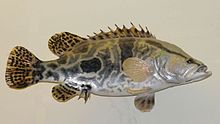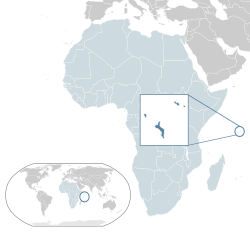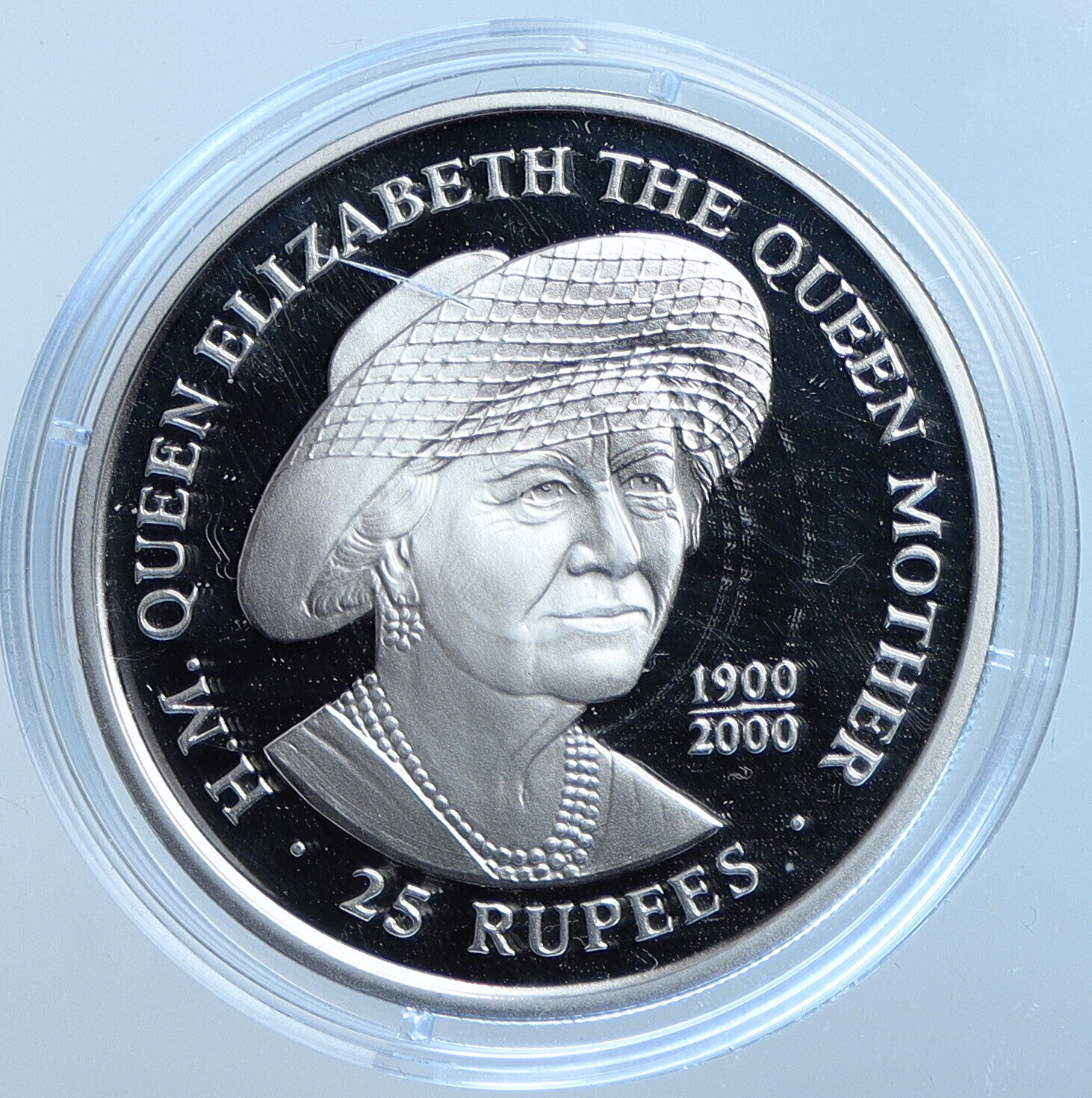|
Seychelles
Conservation – Mandarin Fish
1978 Proof Silver 50 Rupees 38mm (28.46 grams) 0.925 Silver (0.5781 oz. ASW)
Reference: KM# 39, Schön# 39a
REPUBLIC OF SEYCHELLES · 1978 ·, Coat-of-Arms.
50 RUPEES, Mandarin fish.
You are bidding on the exact item pictured, provided with a Certificate of Authenticity and Lifetime Guarantee of Authenticity.
 Siniperca chuatsi, the mandarin fish or Chinese perch (Chinese: 鱖魚 is species of freshwater ray-finned fish from the family Sinipercidae, the Asian perches. Siniperca chuatsi, the mandarin fish or Chinese perch (Chinese: 鱖魚 is species of freshwater ray-finned fish from the family Sinipercidae, the Asian perches.
Siniperca chautsi has a body which is compressed with a protruding lower jaw and the maxilla reaching behind the eyes. The jaws are armed with rows of saw-like teeth. Lower jaw with 4–5 large sharp rays. There are two flat, sharp spines on the posterior margin of the operculum. It has small, round scales. It has a shiny brownish-yellow body marked with randomly situated coloured blotches and spots. They usually have black or dark grey stripes which run from their lips and run through the eyes over the lateral line but do not reach the back. It has a dorsal fin with the front part containing many hard spines with the rearmost having rounded tips. They have rounded pectoral, anal and caudal fins. There are three sharp spines situated in front of both pelvic and anal fins. The maximum recorded total length of 70 centimetres (28 in) and a maximum published weight of 8 kilograms (18 lb).
Sinipercua cuatsi is found in the drainage basin of the Amur River (Russia/China) and in lowland freshwater habitats throughout East China and into Vietnam.
Siniperca chuatsi are found in rivers which have dense growths of aquatic vegetation and water which can be quite turbid in the rainy season. They are demersal piscivores, stalking the fry of other fish species using their acute vision to track their prey before pouncing on them and enveloping them in their large mouth. The species of fish it mostly preys on are diurnal and have good colour vision and high visual acuity in daylight but which have poor night vision. Although it can live in near-freezing water, it only starts feeding when the temperature rises above 15 °C (59 °F) and breeding when it rises above 21 °C (70 °F).
Siniperca chuatsi is a commercially important species, as it is a popular food fish and has been widely farmed in its native range since the 20th century. It first gained major popularity during the Tang dynasty (618–907 A.D.), appearing in many Chinese books and poems. The farmed fish are typically pure, but sometimes hybrids between this species and its close relative the golden mandarin fish (S. scherzeri). The famed Jiangsu dish of squirrel fish is typically prepared with mandarin fish.
Siniperca chuatsi was first formally described as Perca chuatsi in 1855 by the Russian ichthyologist, missionary and physician Stepan Ivanovich Basilewsky (died c. 1867) with the type locality given as “rivers in Hopei Province”. The generic name is a compound of sino meaning “of China” and perca meaning “perch” while the specific name chuatsi is a rendering of the local name of the fish.
»
 Seychelles, officially the Republic of Seychelles (French: République des Seychelles; Creole: La Repiblik Sesel), is an archipelago country in the Indian Ocean. The capital of the 115-island country, Victoria, lies 1,500 kilometres (932 mi) east of mainland East Africa. Other nearby island countries and territories include Comoros, Mayotte (region of France), Madagascar, Réunion (region of France) and Mauritius to the south; as well as the Maldives and Chagos Archipelago to the east. With a population of roughly 94,228, it has the smallest population of any sovereign African country. Seychelles, officially the Republic of Seychelles (French: République des Seychelles; Creole: La Repiblik Sesel), is an archipelago country in the Indian Ocean. The capital of the 115-island country, Victoria, lies 1,500 kilometres (932 mi) east of mainland East Africa. Other nearby island countries and territories include Comoros, Mayotte (region of France), Madagascar, Réunion (region of France) and Mauritius to the south; as well as the Maldives and Chagos Archipelago to the east. With a population of roughly 94,228, it has the smallest population of any sovereign African country.
Seychelles is a member of the African Union, the Southern African Development Community, the Commonwealth of Nations, and the United Nations. After proclamation of independence from the United Kingdom in 1976, Seychelles has developed from a largely agricultural society to a market-based diversified economy, with agriculture being supplanted by rapidly rising service and public sectors as well as tourism. From 1976 until 2015, nominal GDP output has increased nearly sevenfold and the purchasing power parity nearly sixteenfold. In late 2010s, the President Danny Faure and the National Assembly presented plans to encourage foreign investment in order to further upgrade these sectors.
 Today, Seychelles boasts the highest nominal per capita GDP in Africa, excluding the French regions. It is one of only a handful of countries in Africa with a high Human Development Index. Despite the country’s newfound economic prosperity, poverty remains widespread and one finds a high level of economic inequality, one of the highest in the world, and unequal wealth distribution among the populace, the upper and ruling class commanding a vast proportion of the country’s wealth.h. Today, Seychelles boasts the highest nominal per capita GDP in Africa, excluding the French regions. It is one of only a handful of countries in Africa with a high Human Development Index. Despite the country’s newfound economic prosperity, poverty remains widespread and one finds a high level of economic inequality, one of the highest in the world, and unequal wealth distribution among the populace, the upper and ruling class commanding a vast proportion of the country’s wealth.h.
The Seychelles were uninhabited throughout most of recorded history. Some scholars assume that Austronesian seafarers and later Maldivian and Arab traders were the first to visit the uninhabited Seychelles. This assumption is based on the discovery of tombs, visible until 1910. The earliest recorded sighting by Europeans took place on 15 March 1503, recorded by Thomé Lopes aboard “Rui Mendes de Brito” part of the fleet of the Portuguese Admiral Vasco da Gama. Da Gama’s ships passed close to an elevated island, probably Silhouette Island and the following day Desroches Island. The earliest recorded landing was in January 1609, by the crew of the “Ascension” under Captain Alexander Sharpeigh during the fourth voyage of the British East India Company.
 A transit point for trade between Africa and Asia, the islands were said to be occasionally used by pirates until the French began to take control starting in 1756 when a Stone of Possession was laid on Mahé by Captain Nicholas Morphey. The islands were named after Jean Moreau de Séchelles, Louis XV’s Minister of Finance. A transit point for trade between Africa and Asia, the islands were said to be occasionally used by pirates until the French began to take control starting in 1756 when a Stone of Possession was laid on Mahé by Captain Nicholas Morphey. The islands were named after Jean Moreau de Séchelles, Louis XV’s Minister of Finance.
The British frigate “Orpheus” commanded by Captain Henry Newcome arrived at Mahé on 16 May 1794. Terms of capitulation were drawn up and the next day Seychelles was surrendered to Britain. Jean Baptiste Quéau de Quincy, the French administrator of Seychelles during the years of war with the United Kingdom, declined to resist when armed enemy warships arrived. Instead, he successfully negotiated the status of capitulation to Britain which gave the settlers a privileged position of neutrality.
Britain eventually assumed full control upon the surrender of Mauritius in 1810, formalised in 1814 at the Treaty of Paris. Seychelles became a crown colony separate from Mauritius in 1903. Elections were held in 1966 and 1970.
Independence
Independence was granted in 1976 as a republic within the Commonwealth. In the 1970s Seychelles was “the place to be seen, a playground for film stars and the international jet set”. In 1977, a coup d’état by France Albert René ousted the first president of the republic, James Mancham. René discouraged over-dependence on tourism and declared that he wanted “to keep the Seychelles for the Seychellois”.
The 1979 constitution declared a socialist one-party state, which lasted until 1991.
In the 1980s there were a series of coup attempts against President René, some of which were supported by South Africa. In 1981, Mike Hoare led a team of 43 South African mercenaries masquerading as holidaying rugby players in the 1981 Seychelles coup d’état attempt. There was a gun battle at the airport, and most of the mercenaries later escaped in a hijacked Air India plane. The leader of this hijacking was German mercenary D. Clodo, a former member of the Rhodesian SAS. Clodo later stood trial in South Africa (where he was acquitted) as well as in his home country Germany for air piracy.
In 1986, an attempted coup led by the Seychelles Minister of Defence, Ogilvy Berlouis, caused President René to request assistance from India. In Operation Flowers are Blooming, the Indian naval vessel INS Vindhyagiri arrived in Port Victoria to help avert the coup.
The first draft of a new constitution failed to receive the requisite 60% of voters in 1992, but an amended version was approved in 1993.
In January 2013, Seychelles declared a state of emergency; the tropical cyclone Felleng caused torrential rain, and flooding and landslides destroyed hundreds of houses.

George VI (Albert Frederick Arthur George; 14 December 1895 – 6 February 1952) was King of the United Kingdom and the Dominions of the British Commonwealth from 11 December 1936 until his death. He was the last Emperor of India and the first Head of the Commonwealth .
As the second son of King George V , he was not expected to inherit the throne and spent his early life in the shadow of his elder brother, Edward . He served in the Royal Navy and Royal Air Force during the First World War , and after it took on the usual round of public engagements. He married Lady Elizabeth Bowes-Lyon in 1923 and they had two daughters, Elizabeth and Margaret .
George’s elder brother ascended the throne as Edward VIII upon the death of their father in 1936. However, later that year Edward revealed his desire to marry the divorced American socialite Wallis Simpson . British Prime Minister Stanley Baldwin advised Edward that for political and religious reasons he could not marry a divorced woman and remain king. Edward abdicated in order to marry, and George ascended the throne as the third monarch of the House of Windsor .
During George’s reign the break-up of the British Empire and its transition into the Commonwealth of Nations accelerated. The parliament of the Irish Free State removed direct mention of the monarch from the country’s constitution on the day of his accession. Within three years, the Empire and Commonwealth, except the Irish Free State, was at war with Nazi Germany . In the next two years, war with Italy and Japan followed. Though Britain and its allies were ultimately victorious, the United States and the Soviet Union rose as pre-eminent world powers and the British Empire declined. After the independence of India and Pakistan in 1947, George remained as king of both countries, but the title Emperor of India was abandoned in June 1948. Ireland formally declared itself a republic and left the Commonwealth in 1949, and India became a republic within the Commonwealth the following year. George adopted the new title of Head of the Commonwealth. He was beset by health problems in the later years of his reign. His elder daughter, Elizabeth, succeeded him.
|





 Siniperca chuatsi, the mandarin fish or Chinese perch (Chinese: 鱖魚 is species of freshwater ray-finned fish from the family Sinipercidae, the Asian perches.
Siniperca chuatsi, the mandarin fish or Chinese perch (Chinese: 鱖魚 is species of freshwater ray-finned fish from the family Sinipercidae, the Asian perches. Seychelles, officially the Republic of Seychelles (French: République des Seychelles; Creole: La Repiblik Sesel), is an archipelago country in the Indian Ocean. The capital of the 115-island country, Victoria, lies 1,500 kilometres (932 mi) east of mainland East Africa. Other nearby island countries and territories include Comoros, Mayotte (region of France), Madagascar, Réunion (region of France) and Mauritius to the south; as well as the Maldives and Chagos Archipelago to the east. With a population of roughly 94,228, it has the smallest population of any sovereign African country.
Seychelles, officially the Republic of Seychelles (French: République des Seychelles; Creole: La Repiblik Sesel), is an archipelago country in the Indian Ocean. The capital of the 115-island country, Victoria, lies 1,500 kilometres (932 mi) east of mainland East Africa. Other nearby island countries and territories include Comoros, Mayotte (region of France), Madagascar, Réunion (region of France) and Mauritius to the south; as well as the Maldives and Chagos Archipelago to the east. With a population of roughly 94,228, it has the smallest population of any sovereign African country.  Today, Seychelles boasts the highest nominal per capita GDP in Africa, excluding the French regions. It is one of only a handful of countries in Africa with a high Human Development Index. Despite the country’s newfound economic prosperity, poverty remains widespread and one finds a high level of economic inequality, one of the highest in the world, and unequal wealth distribution among the populace, the upper and ruling class commanding a vast proportion of the country’s wealth.h.
Today, Seychelles boasts the highest nominal per capita GDP in Africa, excluding the French regions. It is one of only a handful of countries in Africa with a high Human Development Index. Despite the country’s newfound economic prosperity, poverty remains widespread and one finds a high level of economic inequality, one of the highest in the world, and unequal wealth distribution among the populace, the upper and ruling class commanding a vast proportion of the country’s wealth.h. A transit point for trade between Africa and Asia, the islands were said to be occasionally used by pirates until the French began to take control starting in 1756 when a Stone of Possession was laid on Mahé by Captain Nicholas Morphey. The islands were named after Jean Moreau de Séchelles, Louis XV’s Minister of Finance.
A transit point for trade between Africa and Asia, the islands were said to be occasionally used by pirates until the French began to take control starting in 1756 when a Stone of Possession was laid on Mahé by Captain Nicholas Morphey. The islands were named after Jean Moreau de Séchelles, Louis XV’s Minister of Finance. 
.svg/180px-Coat_of_arms_of_Canada_(1921-1957).svg.png)





